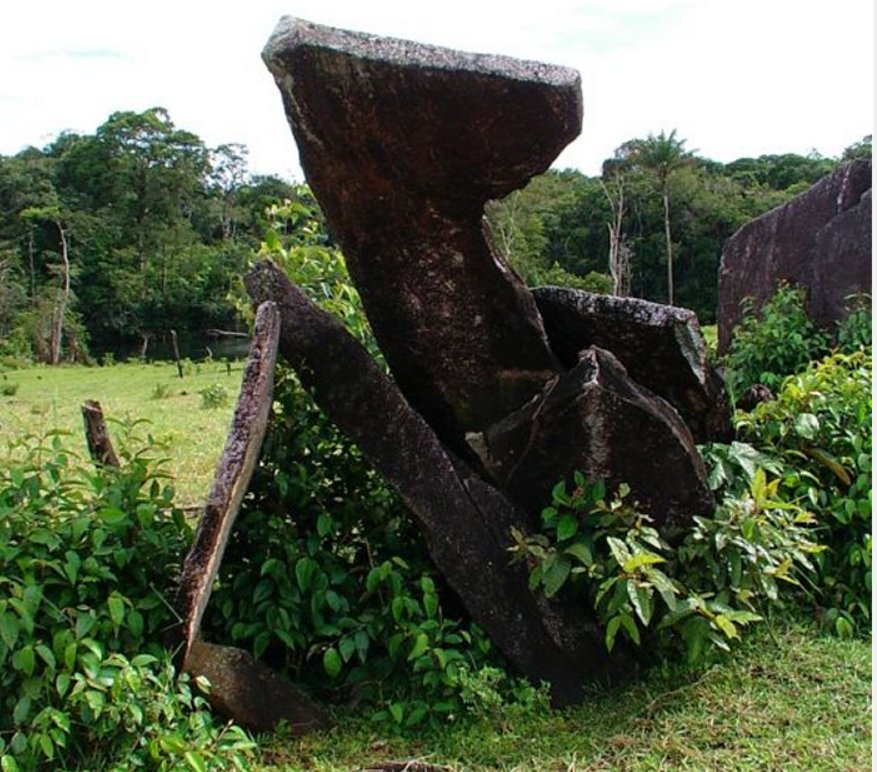Calçoene – Amazon Stonehenge And The Mysterious Amapán Megalithic Culture
Ellen Lloyd - AncientPages.com - In the distant past, people in Brazil raised fascinating megalithic structures still shrouded in mystery. One intriguing monument is Calçoene, also called the Amazon Stonehenge.
The Calzoene's 'Stonehenge' - Image credit: Leandroisola - CC BY-SA 4.0 DEED
The true purpose of this structure remains to be discovered. It could have been used as an ancient astronomical observatory or for burial purposes, or perhaps both.
Discovery Of The Amazon Stonehenge
Megalithic structures in Amapá state, Brazil, near the city of Calçoene, were first reported by naturalist Emilio Goeldi. While exploring the region, he noticed settings of upright stones in the late 19th century.
At this site, archaeologists have uncovered several fascinating artifacts that could shed more light on the mysterious Amapán people.
The Amazon Stonehenge, sometimes called the "Tropical Stonehenge," raises many baffling questions. 2005 Archaeologists began excavating the site in 2005, but a thorough study of the megalithic structures has yet to be conducted.
So far, 20 megalithic structures, eight burial caves, a mound, and some ancient villages have been discovered.
Calçoene Megalithic Structures Reveal Evidence Of Ancient Astronomical Knowledge
For the most part, Amapán megaliths are easily visible and located on the tops of hills. The stones vary much in size. The megaliths consist of upright or slanted granite blocks in circular arrangements. Some circles are small, less than 10 m in diameter.
A megalithic stone circle in Calçoene, Brazil. The site also called the Amazon Stonehenge.The largest stone structure has a diameter of more than 30 m. The granite stones are rough and straightforward. Image source: Wikipedia commons.
The stones have yet to be submitted to dating techniques, but the carbon-dating of unearthed pottery suggests the site is between 500-2,000 years old.
Studies of the Amazon Stonehenge reveal a connection between the stone structures and the Amapá culture's interest in astronomy. The Stonehenge comparison with the Amazon discovery is due to the astronomical significance of both sites.
On the winter solstice of December 21, the shortest day of the year in the northern hemisphere, the shadow of one of the blocks disappears when the sun is directly above it. The rock has been placed at an angle so that the shadow is possibly tiny throughout the day. This particular block's alignment with the December solstice leads archaeologists to consider the possibility that the site was once an astronomical observatory. During the winter solstice, the sun shines directly through this hole onto another rock for an extended time.
If the stone structure served as a megalithic observatory, then it must have been constructed by sophisticated indigenous culture.
Many of the world's indigenous peoples are thought to use the symbolism of the sky on Earth to harness the power of the celestial world. It would seem that the Amapá megalithic culture was also fascinated with the night sky and heavenly bodies.
The Amazon Stonehenge could re-write the ancient history of ancient societies in South America. Therefore, the stone circles must be studied in more detail. Scientific examinations of the archaeological sites can provide us with more clues and hopefully answers as to the age of the Amapán megalithic culture and its mysterious disappearance.
Written by Ellen Lloyd – AncientPages.com
Updated on January 16, 2024
Copyright © AncientPages.com & Ellen Lloyd All rights reserved. This material may not be published, broadcast, rewritten or redistributed in whole or part without the express written permission of AncientPages.com and Ellen Lloyd
More From Ancient Pages
-
 Unusual Neolithic Burial From Grotta Di Pietra Sant’ Angelo Puzzles Archaeologists
Featured Stories | Jan 15, 2024
Unusual Neolithic Burial From Grotta Di Pietra Sant’ Angelo Puzzles Archaeologists
Featured Stories | Jan 15, 2024 -
 Codex Gigas – The Devil’s Bible – Ancient Secrets Of The World’s Largest Book
Artifacts | Jun 15, 2014
Codex Gigas – The Devil’s Bible – Ancient Secrets Of The World’s Largest Book
Artifacts | Jun 15, 2014 -
 First AI-Based Method For Dating Archaeological Remains Developed By Researchers
Archaeology | Aug 23, 2022
First AI-Based Method For Dating Archaeological Remains Developed By Researchers
Archaeology | Aug 23, 2022 -
 Never-Before-Seen Ancient Texts Hidden In Saint Catherine’s Monastery In Sinai Are Now Available Online
Archaeology | Dec 21, 2017
Never-Before-Seen Ancient Texts Hidden In Saint Catherine’s Monastery In Sinai Are Now Available Online
Archaeology | Dec 21, 2017 -
 Humans Have Been In The Arctic For Over 40,000 Years – New Discoveries Reveal
Archaeology | Jul 12, 2022
Humans Have Been In The Arctic For Over 40,000 Years – New Discoveries Reveal
Archaeology | Jul 12, 2022 -
 Ars Amatoria – Ancient Roman Flirting Tips – Could They Still Work?
Featured Stories | Mar 26, 2019
Ars Amatoria – Ancient Roman Flirting Tips – Could They Still Work?
Featured Stories | Mar 26, 2019 -
 Scotland’s First Farmers Didn’t Need Manure To Fertilize Their Fields – The Land Was Still Very Productive
Archaeology | Oct 12, 2022
Scotland’s First Farmers Didn’t Need Manure To Fertilize Their Fields – The Land Was Still Very Productive
Archaeology | Oct 12, 2022 -
 1,500-Year-Old Christian Reliquary Found In An Unknown Church In Irschen, Austria
Archaeology | Jun 26, 2024
1,500-Year-Old Christian Reliquary Found In An Unknown Church In Irschen, Austria
Archaeology | Jun 26, 2024 -
 China’s Ancient Water Pipes Show People Mastered Complex Engineering Without The Need For A Centralized State Authority
Archaeology | Aug 15, 2023
China’s Ancient Water Pipes Show People Mastered Complex Engineering Without The Need For A Centralized State Authority
Archaeology | Aug 15, 2023 -
 Egyptian Tomb Of The Two Brothers – DNA Solves Ancient Egyptian Mystery
Archaeology | Jan 17, 2018
Egyptian Tomb Of The Two Brothers – DNA Solves Ancient Egyptian Mystery
Archaeology | Jan 17, 2018 -
 Minutes Did Not Exist During The Middle Ages
Ancient History Facts | Mar 2, 2016
Minutes Did Not Exist During The Middle Ages
Ancient History Facts | Mar 2, 2016 -
 White Temple Of God Anu In Sacred Precinct Of Kullaba At Uruk
Civilizations | Oct 10, 2016
White Temple Of God Anu In Sacred Precinct Of Kullaba At Uruk
Civilizations | Oct 10, 2016 -
 Food In Ancient Roman Funerary Meals Was Similar To That Consumed During Life
Archaeology | Aug 30, 2022
Food In Ancient Roman Funerary Meals Was Similar To That Consumed During Life
Archaeology | Aug 30, 2022 -
 Olive Trees Were First Domesticated 7,000 Years Ago In The Jordan Valley
Archaeology | Jun 17, 2022
Olive Trees Were First Domesticated 7,000 Years Ago In The Jordan Valley
Archaeology | Jun 17, 2022 -
 Great Pyramid of Cholula Is The Largest In The World Today
Ancient History Facts | Feb 9, 2016
Great Pyramid of Cholula Is The Largest In The World Today
Ancient History Facts | Feb 9, 2016 -
 Two Stone Age 9,500-Year-Old Artifacts Unearthed In Tel Motza
Archaeology | Sep 3, 2012
Two Stone Age 9,500-Year-Old Artifacts Unearthed In Tel Motza
Archaeology | Sep 3, 2012 -
 First Genome-Wide Ancient Human DNA From Sudan Shines New Light On Nile Valley Past
Archaeology | Dec 20, 2021
First Genome-Wide Ancient Human DNA From Sudan Shines New Light On Nile Valley Past
Archaeology | Dec 20, 2021 -
 Balbals – Ancient Stone Guards Of The Kazakh Steppe
Artifacts | Dec 21, 2015
Balbals – Ancient Stone Guards Of The Kazakh Steppe
Artifacts | Dec 21, 2015 -
 Magnificent 2 Meters Tall Marble Apollo Statue And Other Artifacts Found In San Casciano dei Bagni, Italy
Archaeology | Nov 20, 2023
Magnificent 2 Meters Tall Marble Apollo Statue And Other Artifacts Found In San Casciano dei Bagni, Italy
Archaeology | Nov 20, 2023 -
 Gold Spiral In Early Bronze Age Grave – Unearthed
Archaeology | Jun 1, 2021
Gold Spiral In Early Bronze Age Grave – Unearthed
Archaeology | Jun 1, 2021


